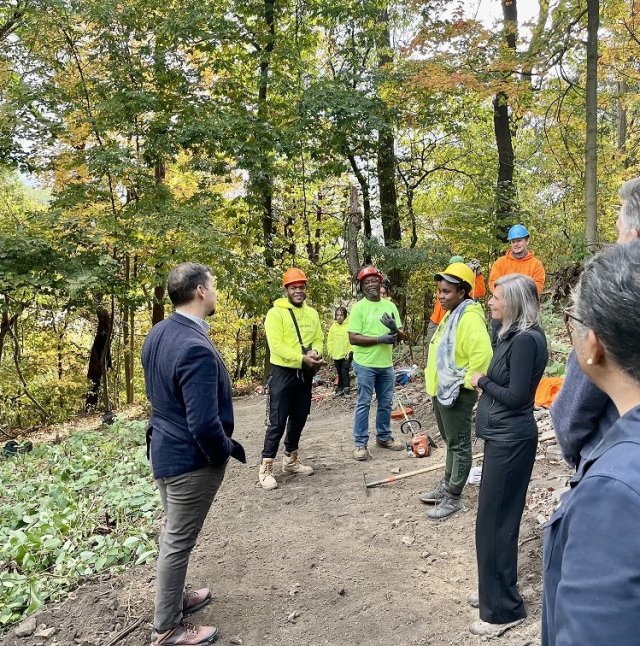EPA Brownfields Job Training Grants, funded through the Bipartisan Infrastructure Law, build a skilled environmental workforce in overburdened communities
October 12, 2023
Contact Information
R3 Press (R3press@epa.gov)
PITTSBURGH (October 12, 2023) – U.S. Environmental Protection Agency Regional Administrator Adam Ortiz visited the Beechview-Seldom Seen Greenway in Pittsburgh today to witness firsthand the work of Landforce, a land stewardship and workforce development organization.

EPA Regional Administrator Adam Ortiz stands with Brownfields Job Training Grant Program graduates.
Landforce is one of two Allegheny County organizations selected by EPA for funding under its fiscal year 2023 Brownfields Job Training Grant competition. EPA selected Landforce and Auberle to each receive approximately $500,000 to recruit, train, and retain local, skilled individuals. The recruitments will prioritize unemployed or under-employed adults who have faced barriers to stable, family- sustaining employment.
“The Brownfields Job Training Grant Program not only improves communities, it has the power to change lives,” said EPA Regional Administrator Adam Ortiz.“Graduates develop the skills needed to secure full-time, sustainable employment in the environmental field - a win across the board.”
Established in 2015, Landforce has received a total of $700,000 from two EPA brownfield remediation and workforce development multi-year grants to recruit and train adults with barriers to employment, using a rigorously designed curriculum that covers both hard and soft skills, combined with actual employment stewarding Pittsburgh's degraded lands.
In the past eight years, Landforce has trained 147 people and brought 126 of them on as crew members. In addition to this year’s job training grant, they are also the recipient of a $149,336 Solid Waste Infrastructure Grant, which will allow them to divert 625 tons of urban wood waste annually from landfills.
“We’re grateful for federal investments from our partners at US EPA for helping us turn a vision into a reality. With these funds, not only can we continue our current programming - we can now expand to year-round opportunities. In addition to job training, our portfolio will now include the full life cycle management of trees, diverting wood waste from landfills, and giving fallen trees new life,” said Ilyssa Manspeizer, Ph.D. Executive Director, Landforce.
Based in McKeesport, Auberle plans to train 130 students and place at least 95 in environmental jobs amongst their 130 employing partners and 100 referral agencies through the region. The training program includes 115 hours of instruction in 40-Hour HAZWOPER, 32-Hour Asbestos, Lead Renovation and Repair, Confined Space Entry, OSHA-10, Bloodborne Pathogens, and CPR/ First Aid. Students who complete the training will earn up to one state and seven federal certifications. Auberle is targeting students within Allegheny County, specifically chronically underemployed, unemployed, and at-risk individuals.
“Auberle’s Brownfields Job Training Program changes lives by putting local people to work in places that have been impacted by industry, helping to revitalize their own communities while lifting themselves and their families out of poverty. We are grateful to the EPA for providing this impactful funding,” said Abby Wolensky, Auberle’s Director of the Employment Institute.
"Witnessing the EPA Brownfields Job Training Grants unfold at the Beechview-Seldom Seen Greenway is symbolic of the transformative, hands-on environmental and employment work occurring in Pittsburgh. Organizations like Landforce and Auberle are making our communities stronger and more resilient. They're cleaning up our environment and, at the same time, giving people who need jobs the training they need to get them. It's about taking care of our neighborhoods and each other at the same time. This is not only a revitalization of our lands, but a direct investment in our people, providing them not just with jobs, but with careers that uplift them, their families, and our communities. Together, we're fixing our environment and giving people good, strong job skills for the future. What we're doing now in Allegheny County and all over the region will make things better for our kids and grandkids, and I'm excited to help heal our environment and our neighbors at the same time," said U.S. Congresswoman Summer Lee.
Background:
President Biden’s leadership and bipartisan Congressional action have delivered the single-largest investment in U.S. brownfields infrastructure ever through the Bipartisan Infrastructure Law, which invests more than $1.5 billion over five years through EPA’s highly successful Brownfields Program. The Brownfields Jobs Training Program also advances President Biden’s Justice40 Initiative, which aims to deliver at least 40 percent of the benefits of certain government programs to disadvantaged communities.
The EPA’s Brownfields Job Training (JT) grant program is a unique employment and training program. The grants allow nonprofit and other eligible organizations to recruit, train, and retain a local, skilled workforce by prioritizing unemployed and under-employed, including low-income individuals living in areas impacted by solid and hazardous waste in environmental jobs. Students learn the skills and credentials needed to secure full-time, sustainable employment in the environmental field, including brownfields assessment and cleanup. These jobs reduce environmental contamination and build more sustainable futures for communities. Communities have the flexibility to deliver eligible training that meets the local labor market demands of the environmental sector in their communities.
Since 1998, EPA has awarded 400 job training grants. With these grants, more than 20,600 individuals have completed training and over 15,300 individuals have been placed in careers related to land remediation and environmental health and safety.
Learn more on EPA’s Brownfields Program.

